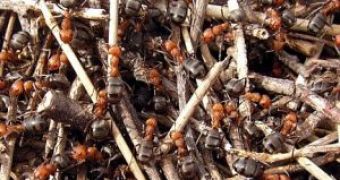Scientists at the University of Sussex have looked at how the wood ants roam over proportionally huge distances, with their poor eyesight and confusing and changing natural landmarks.
When an ant goes for the first time to a food source, it follows a chemical trail left by earlier ants. This way of moving around is very slow, because the ants have to constantly pick up the scent of their fellows.
But the scientists proved that ants actually memorize the route. They store images of the route encompassing landmarks and views of the whole landscape. Ants use their memories for back and forth movements in search of food. Their memory capacity is quite remarkable and they possess the capacity to activate the right ones.
Ants' capacities were studied in lab experiments. "To show that ants use visual memory to navigate we trained ants to find food 10cm from a cylinder. We then doubled the size of the cylinder and the ants searched for the food at 20cm away where the retinal size of the landmark was the same." explained Professor Tom Collett from the University of Sussex Centre for Neuroscience.
The remembering capacities of these tiny insects were analyzed by putting them in an ambiguous situation. Ants were taught to find food between two cylinders of different sizes and then the cylinders were replaced by two of the same size. They were able to find again their feeding place only when a patterned background was introduced as a visual cue. "To know which cylinder was which ants needed the patterned background to be in a different position on the retina when they faced one or other cylinder. Accurate memory retrieval often relies on ants storing a large panorama." said Collett.
The study of the ant's orientation could help to design autonomous robots. "Insect behavior is much more 'machine-like' than that of mammals, and ants are a lot less flexible in their use of navigational strategies. This stereotypy makes it easier to understand how their strategies operate and to design robots that navigate following similar principles." explained Collett.
Further experiments will detail about insect visual-motor behavior. "Cognitive systems research gives us the opportunity to learn more about the ways that animals, including humans, process information to learn, reason, make decisions and communicate." said Professor Julia Goodfellow, Chief Executive of BBSRC.

 14 DAY TRIAL //
14 DAY TRIAL //